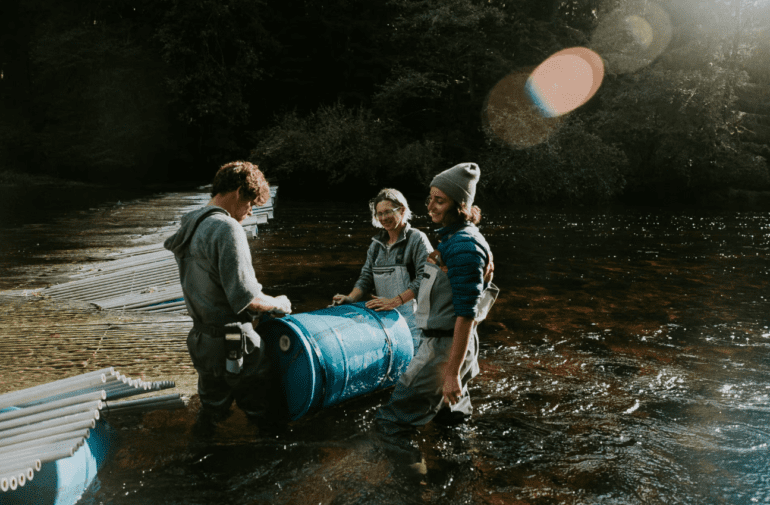TL;DR:
- First Nations use AI to monitor salmon populations, allowing for the confident harvest of sockeye salmon.
- The Heiltsuk Nation successfully implemented an AI counting system that tracks salmon 24/7 and identifies specific species.
- AI collaboration with traditional monitoring methods empowers First Nations to make informed decisions about salmon harvesting.
- AI technology provides real-time data, filling major data gaps in salmon conservation.
- The partnership between Indigenous communities, AI technology, and environmental organizations promises to secure the future of salmon populations in British Columbia.
Main AI News:
First Nations communities are harnessing the power of artificial intelligence (AI) to protect salmon populations and secure their sustainable future. The Heiltsuk Nation, situated on the central coast of British Columbia, recently achieved a significant milestone by confidently harvesting sockeye salmon after years of abstinence. This success story is attributed to a cutting-edge AI monitoring system implemented by the community, addressing the critical issue of declining salmon populations.
For decades, the Heiltsuk Nation refrained from fishing sockeye due to uncertainties surrounding the salmon population’s health. Traditional monitoring methods were hindered by a lack of up-to-date and accurate data, as federal budget cuts significantly impacted salmon monitoring efforts. Faced with these challenges, the Heiltsuk Nation took matters into their own hands.
Last summer, the Heiltsuk Nation fully embraced a state-of-the-art AI counting system installed at their fish weir on the Koeye River, located within the Great Bear Rainforest. This AI system operates 24/7, accurately counting passing salmon and even identifying specific species. Armed with this real-time data, the nation made informed decisions regarding salmon harvests, distributing approximately 500 salmon to the community, a significant achievement given the declining salmon stocks.
While this harvest is far from historic levels, the joy and excitement among the community members were palpable. In today’s context, with depleted salmon stocks commanding high prices, the distribution of just three sockeye per household was celebrated as a win. William Housty, associate director of the Heiltsuk Integrated Resource Management Department, described the scene as reminiscent of winning the lottery.
The success of the Heiltsuk Nation’s AI monitoring system has spurred approximately a dozen other First Nations to collaborate with scientists in training AI models for real-time salmon tracking. This innovative approach holds immense potential to revolutionize salmon conservation efforts by providing crucial data for managing populations threatened by habitat loss and rising temperatures.
Traditionally, communities lacked precise information about salmon passage in waterways, often relying on preseason forecasts or harvesting without adequate abundance data. AI technology offers a more efficient and accurate solution compared to labor-intensive and costly manual fish counting methods. The collaboration between AI and traditional First Nations techniques enhances the accuracy and reliability of data, empowering these communities to manage their resources effectively.
The utilization of AI in salmon monitoring projects promises to surpass the capabilities of Fisheries and Oceans Canada (DFO) by providing more accurate and timely data. Will Atlas, a salmon watershed scientist, envisions that this high-quality, in-season data will put First Nations in the driver’s seat when it comes to fisheries decision-making, marking a significant shift in their autonomy and control over resources.
The AI monitoring system, which uses high-definition cameras powered by solar energy and communicates results via satellite, has been developed and trained by a team of computer scientists at Simon Fraser University. Known as SalmonVision, this technology excels at object detection and multi-object tracking, achieving impressive accuracy scores for various salmon species.
Janvier Doire, a fish biologist and co-author of the study, highlights the significance of First Nations owning and producing their data, emphasizing the newfound autonomy and independence this technology affords these communities. While the initial setup costs around $50,000, the long-term benefits and decreasing operational costs make it a worthwhile investment.
The combination of AI and traditional monitoring methods enables First Nations to make more informed decisions about salmon harvesting, ensuring the sustainability of salmon populations for future generations. This collaborative effort not only fills major data gaps in salmon conservation but also provides hope in the face of habitat degradation and rising temperatures.
Salmon populations, vital to First Nations’ cultural and ecological heritage, have significantly declined due to industrialization and colonization impacts. Diverse factors, such as logging, infrastructure development, ocean temperature increases, and salmon hatcheries, contribute to the challenges faced by these populations.
The AI technology’s ability to provide real-time data empowers communities to respond effectively to these challenges, enhancing their capacity to manage their resources. Christina Service, science lead at Kitasoo Xai’xais Stewardship Authority, underscores the potential of AI to transform salmon monitoring and improve food security in remote communities.
Despite concerns about the ethics of AI, particularly in decision-making, community members like William Housty emphasize that technology is a tool for collecting data, not making decisions. The integration of Western science with traditional knowledge represents a culmination of efforts to ensure the long-term sustainability of salmon populations.
As First Nations continue to embrace AI technology, the potential for scaling up these projects and expanding their benefits to more communities becomes increasingly evident. The collaboration between Indigenous communities, AI technology, and environmental organizations offers a promising path toward securing the future of salmon populations throughout British Columbia.
Conclusion:
The integration of AI technology with traditional knowledge in salmon conservation is a game-changer for First Nations, providing them with the tools to make informed decisions about sustainable salmon harvesting. This innovative approach addresses major data gaps, enhances autonomy, and ensures the long-term sustainability of salmon populations. As AI continues to play a pivotal role in conservation efforts, it opens up opportunities for technology-driven solutions in the broader environmental market.

